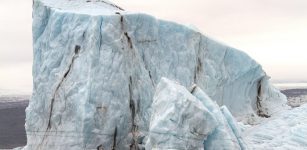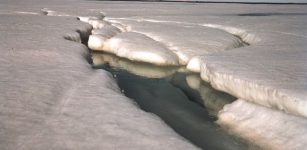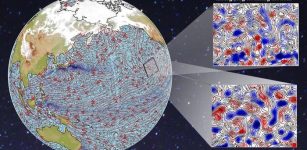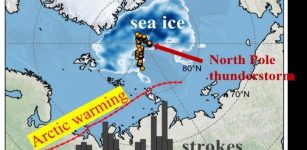Blowing Snow Contributes To Arctic Warming
Eddie Gonzales Jr. – MessageToEagle.com – Atmospheric scientists led by Jian Wang discovered abundant fine sea salt aerosol production from wind-blown snow in the central Arctic, increasing seasonal surface warming.
Image credit: Pixabay
When it comes to global warming trends, the Arctic is a troubling outlier. The Arctic warms nearly four times faster than the global average, and aerosols play an important role in that warming. Scientists have long known that pollutants from other regions can accumulate in the Arctic atmosphere where they alter atmospheric chemistry, absorb sunlight, and affect local weather patterns, leading to localized warming that melts ice and snow. Sea salt particles dominate aerosol mass concentration, but their production mechanisms and impact on Arctic climate have remained unclear.
“Over the past few decades, scientists have identified ‘Arctic haze’ as the primary source of aerosols in the Arctic during winter and spring. This haze results from the long-range transport of pollutants,” said Xianda Gong, first author on the study and a former postdoctoral researcher in Wang’s lab. “However, our study reveals that local blowing snow, which produces sea salt particles, contributes a more substantial fraction to the total aerosol population in the central Arctic.”
Wang’s team analyzed data collected by the Multidisciplinary drifting Observatory for the Study of Arctic Climate (MOSAiC). Such observations are difficult to obtain – the MOSAiC expedition entailed international collaboration and freezing an icebreaker into the central Arctic ice pack to drift with the sea ice for an entire year – but essential to understanding the full picture of atmospheric conditions in the Arctic.
“The MOSAiC expedition let us observe how aerosols and clouds evolve over the course of a year and led to this discovery,” Wang said. “Sea salt particles in the Arctic atmosphere aren’t surprising, since there are ocean waves breaking that will generate sea salt aerosols. But we expect those particles from the ocean to be pretty large and not very abundant. We found sea salt particles that were much smaller and in higher concentration than expected when there was blowing snow under strong wind conditions,” Wang said.
In the central Arctic, the coldest winter nights are the clearest, when heat from Earth can escape into space unimpeded. Under a cozy blanket of clouds, though, longwave radiation gets trapped and contributes to warming, so any process that leads to increased cloud formation and lingering cloudiness also boosts surface temperatures. Small aerosol particles, including those fine sea salt aerosols produced by blowing snow that Wang’s team discovered, turn out to be very good for cloud formation.
“These sea salt particles can act as cloud condensation nuclei, leading to cloud formation,” Gong said. “Considering the absence of sunlight in the winter and spring Arctic, these clouds have the capacity to trap surface long-wave radiation, thereby significantly warming the Arctic surface.”
Though scientists had not observed this phenomenon before, fine sea salt aerosols from blowing snow have always been part of the Arctic climate system. With this observational confirmation and systematic study, which revealed that sea salt particles produced from blowing snow account for about 30% of total aerosol particles, climate models can now be updated to include the effects of these fine particles.
“Model simulations that don’t include fine sea salt aerosols from blowing snow underestimate aerosol population in the Arctic,” Wang said. “Blowing snow happens regardless of human warming, but we need to include it in our models to better reproduce the current aerosol populations in the Arctic and to project future Arctic aerosol and climate conditions.”
Written by Eddie Gonzales Jr. – MessageToEagle.com Staff











